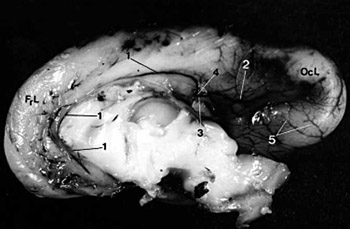Study of the changes in the position and the pattern of changes of the brain arteries in fetuses and full-term stillborns
DOI:
https://doi.org/10.17305/bjbms.2004.3374Keywords:
brain arteries, fetuses, full-term, stillbornAbstract
We studied cerebral blood vessels in 20 fetuses of the gestation age between 16-36 weeks, and in 5 full-term stillborn cadavers by the method of dissection. One portion of the brain samples were processed by filling the blood vessels with 10% solution of formalin, whereas in the other group we used Mixobar and injected it through carotid artery to demonstrate brain arteries. In early fetal life the arteries are thin and have a straightforward pattern, which is in a direct correlation with the development of the brain. In brain arteries of a 28-week old fetus we observed progressive changes at all three brain arteries that began to assume more curved pattern. Since a significant increase in the brain growth and formation of the gyruses and sulcuses of the brain occurs in the 32nd week, the arteries also assume a wavier pattern, and the number of its branches increases. In full-term stillborns, the arteries are much larger in caliber, they branch abundantly, and due to relatively wide brain sulcuses we may also conclude that their pattern is partially tortuous. From our results it is evident that there are changes in the position, pattern and relationship of brain arteries that are parallel with the brain development and formation gyruses and sulcuses of the brain.
Citations
Downloads

Downloads
Published
How to Cite
Accepted 2018-03-15
Published 2004-08-20









